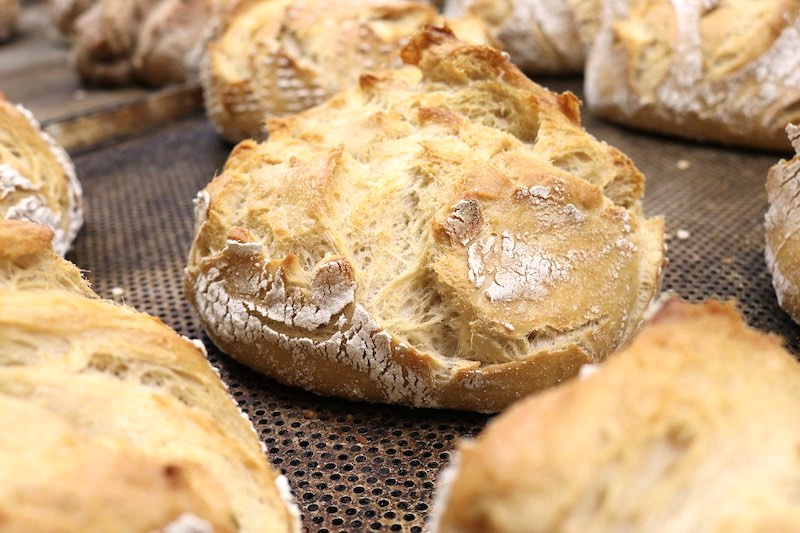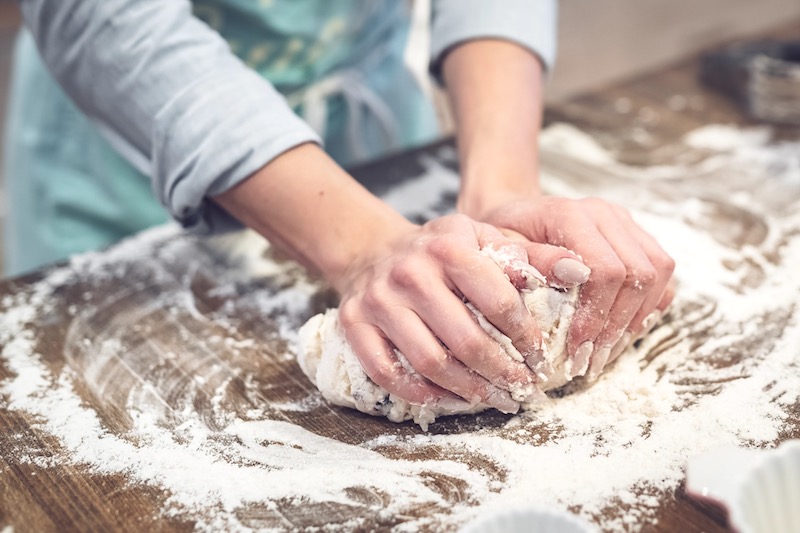Keeping sourdough starter healthy is not as hard as most people make it out to be. You don’t even need commercial yeast! Here’s everything you need to know on how to feed sourdough starter.
RELATED: Sourdough Bread Recipe
In this article:
- Step-by-Step Guide on How to Feed Sourdough Starter
- Dehydrating Sourdough Starter
- Common FAQs About Storing Sourdough Starter
What Every Baker Should Know on How to Feed Sourdough Starter (Plus Tips)
Step-by-Step Guide on How to Feed Sourdough Starter
Step 1: Stir and Discard
Take out the jar of sourdough starter and mix the ingredients well. Then, pour out around 1/2 or 3/4 of the starter in a bowl.
You can either discard this starter or use it for baking. Whatever the case, you are not allowed to feed and store more than 1/2 of the sourdough starter.
Some bakers argue that discarding half of their starter is wasteful. This might be true. However, it is necessary for maintenance and feeding purposes.
Your starter will keep getting bigger if you do not discard some of it. You will soon run out of storage space and have more starter than you can store, feed, or bake.
Step 2: Feed the Sourdough Starter
Now it’s time to feed the sourdough starter. The idea here is to use equal parts of flour, water, and starter.
For example, if you have 1/4 cup of starter left, stir in 1/4 cup of flour and 1/4 cup of water. Your goal would be to feed it with the necessary nutrients to keep it alive without exceeding the volume you had originally stored.
Step 3: Stir Then Let Rest
Stir the ingredients together until they combine then let it rest at room temperature. After one to two hours, the starter should turn light and bubbly, that’s your cue to seal the jar and store it back in the refrigerator.
Dehydrating Sourdough Starter
Think of sourdough starter as a pet. You need to feed it with the right nutrients once or twice a week to keep it alive, healthy, and usable.
Miss even one feeding session and you would put the entire batch at risk. This is especially heartbreaking for those who have been maintaining their sourdough starter for months now.
Sadly, there will come a time where you will be unable to attend to your sourdough. Maybe you'll be going on vacation, attending an out-of-town business conference, or taking on a new project that would eat up your time.
What do you do when you cannot feed your starter? Do you just leave it in the refrigerator and hope for the best?
The answer is a big no! If certain circumstances prevent you from sticking to the regular feeding schedule, opt to dehydrate your sourdough starter instead.
It won't last as long as the starter you feed and maintain regularly, but it will stay alive and healthy for at least a few months. Maybe even a year.
This is more than enough time for someone who needs to take a break from the regular feeding, maintenance, and baking routine.
RELATED: How To Bake A Healthy Banana Bread Recipe From Scratch
Step 1: Prepare the Sourdough Starter
The first thing you need to do is to feed your sourdough starter. Mix with flour and water then let it rest for one to two hours until the mixture turns light and bubbly.
Step 2: Spread the Sourdough Starter on the Parchment Paper
Next, line two pieces of parchment paper on a clean baking sheet. This is to make it easier for you to handle the wet, gooey starter mixture.
Then, spread the mixture as thinly as possible using a spatula. If you spread the mixture too thick, the starter might take too long to dry.
Step 3: Leave the Mixture to Dry
Once the mixture is spread out on the parchment paper, let it sit at room temperature until it completely dries. The end product should look like a thin, brittle chocolate crisp.
How long will you leave the sourdough starter to dry? Well, it depends on where you live and what the weather is like at the moment.
If you live in a warm, sunny state and are dehydrating your sourdough starter in the middle of summer, the entire process shouldn’t take more than a day. But if you live in a cold state where it’s always raining, the starter will take a few days to dry.
You can opt to dry the starter in the oven, but be careful. As much as possible, only turn on the oven’s electric light since the heat it produces is much more gentle and constant.
Be careful not to switch the oven on. High heat will kill your sourdough and make it unusable.
Step 4: Break into Pieces and Store
Break the dried starter into multiple pieces then store in a clean, airtight jar. Store in a cool, dry place that’s away from direct sunlight or heat.
Note: Do not refrigerate your dehydrated sourdough starter.
Common FAQs About Storing Sourdough Starter

1. Should I dehydrate or feed my sourdough starter?
Most people would think that dehydration is the best way to store sourdough starter since it requires far less maintenance, but that is not always the case.
If you bake on a regular basis, opt to feed and maintain your starter. Dehydrating, rehydrating, and activating sourdough starter every time you have to bake is a tedious, time-consuming process.
Dehydration is ideal for those who won't be baking for the next few months or so.
2. Do I have to throw away sourdough starter discards?

No! Sourdough starter discards are not necessarily inedible. You can still use them to make flatbread, pancakes, cakes, pizza, waffles, and other baked goodies. Just don't use discards to make sourdough bread.
3. Is it better to place my sourdough starter in the freezer?
Most people assume that storing food items at colder temperatures is always better. However, that rule does not apply to sourdough starter.
The ideal storing temperature of food varies on a case-by-case basis. And when it comes to sourdough starter, you should never place it in the freezer. Doing so will just kill it.
Check out this video by Amy Duska for a visual guide on how to feed and maintain sourdough starter:
The main takeaway is to mix in flour and water into your sourdough mixture once every week to ensure it gets the nutrients it needs to stay healthy. Also, keep the starter refrigerated when not in use.
Overall, if you feed and store the starter properly, it’s not impossible to keep the mixture alive for a couple of years. Some bakers claim they can even keep dried sourdough starter edible for more than a decade.
Did this guide help you learn how to feed sourdough starter? Feel free to post any questions you have in the comments section below!
Fellow homesteaders, do you want to help others learn from your journey by becoming one of our original contributors? Write for us!
Up Next:

I started my starter but the potatoes didn’t mash down some stayed whole what should I do